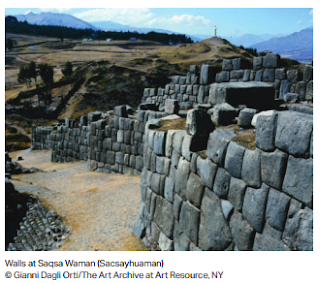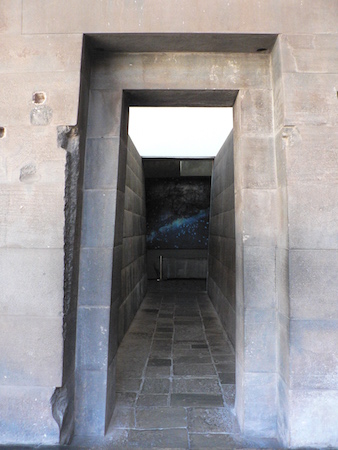^^ Sacsayhuamán^^
Central highlands, Peru. Inka. c. 1440 C.E.; convent added 1550-1650 C.E. Andesite
Cuzco, which had a population of up to 150,000 at its peak, was laid out in the form of a puma and was dominated by fine buildings and palaces, the richest of all being the sacred gold-covered and emerald-studded Coricancha complex which included a temple to the Inca sun god Inti.
Complete Identification:
City of Cusco, including Qorikancha (Inka main temple), Santo Domingo (Spanish colonial convent), and Walls at Saqsa Waman (Sacsayhuaman)
No known artist
c. 1440 CE, convent added 1550-1650 CE
Andesite
Inca
Central highlands, Peru, elevation of 11,200 feet
Form:
Red roofs
Buildings are close together
The city was built on a flat valley that is surrounded by a mountain range –– ideal place for a settlement
Fertile land
Fed by several rivers
Extremely organized
Technical stone constructions
Stones at Sacsayhuamán are huge (two or three times the size of humans)
Urban layout
Function:
Capital of Tawantinsuyu (“Land of the Four Quarters,” name for the Inca empire in Quechua)
Divided into four quarters that represent the four divisions of the empire
People in each section are specific to that division
Two main sections → hanan (upper/high) and hurin (lower)
Axis mundi → center of existence
Inca rulers and nobles lived in Cusco, as well as local leaders
Women came to Cusco to become acllas (“chosen women”), to weave cloth for deities and nobles, and to make chicha (“corn beer”), serve in shrines, sometimes chosen for marriage
Men brought to Cusco for education
Gods and mummies kept in the capital
Qorikancha
In the center of the hurin
Most sacred shrine of the Inca → to the sun god Inti
Imaginary lines called ceques connected to other shrines
Was later turned into a Christian temple
Monastery of Santo Domingo built around it
Sacsayhuamán
Built as a fortress, but function is debated
Left unfinished? Possibly because of colonization
Ancestral conditions
Content:
City is thought to be laid out like a puma (symbol of strength)
The stone construction shows the advanced ability of the society with aesthetic values and structures
The nobles’ houses were separated from the rest of the city
The architecture and urban layout solidified the city’s importance as a political power
Masonry demonstrates understanding of how stone is put together
Each stone was modified with tools so that it fit with its neighboring stones (some had up to 12 sides because of this process)
Stones had room for a little bit of room to wiggle → so that earthquakes would not destroy it
Gods (captured) and mummies in the city were used to further control followers
City represents 3,000 years of indigenous and autonomous cultural development in Peruvian southern Andes
Qorikancha
Ceques radiating from Qorikancha also served as markers of time and “landscape calendar and cosmogram”
Renovated by emperor Pachacuti Inca Yupanqui
He had a divine revelation → divine king
Doorways and wall niches are Inca trapezoids
Doorways are double-jammed to signify importance
The exceptional masonry is reserved for important buildings
Walls covered in thin sheet of gold → representing the sun (Inti)
Inside → garden made out of jewels and precious metals (with people, animals, plants)
Later stolen and melted down by conquistadors
Sacsayhuamán
Northwest of Cusco
Parts could have been left uncompleted → possibly because of colonization
Stones are much larger than the ones used for the Cusco houses
Quarried and hauled into place using manpower
Under the mit’a → labor tax applying to all able-bodied people
canchas (housing units)–– kept intact architectural components and works of art inside structures
Context:
15th century–– the city was redesigned and remodelled after a pre-Inca occupation
Inca Empire
Rose in the Andes mountains in the 13th century, lasted until Spanish conquest in the 16th century
Very important (practically the primary) deity is the sun god Inti
Patron saint of Cusco
Emperor is called → Sapa Inti → son of the sun
Did not have many features associated with old world (wheel, animals to ride and pull plows, knowledge of iron and steel, written system)
Known for monumental architecture, extensive road network, textiles, use of quipu (knots) for record keeping and communication, agricultural accomplishments (especially in the harsh environment), and their political structure
Did not have a money system
Instead, labor and goods were exchanged
Taxes were paid in the form of labor
Rulers then granted access to land and hosten celebrations
Important coming of age ceremony at three years of age → rutuchikuy
High infant mortality rate, so babies are not invested in much until they reach three years old
Each family member would cut off a piece of hair to keep, then the father cuts off the rest
Coming of age/maturation ceremonies when they become sexually able and potent
Celebration for men → performance, new clothes, shows of strength
Girls are made go into the forest and fast until bleeding stops then come back and be celebrated
Inti Raymi
Ceremony of the sun and sun god, which they highly worshipped
It was limited and later banned when the Spanish took over
Men and women were seen as equal
Women were weavers and did a lot of domestic work
Men did a lot of the farming, combat, and herding (spun and wove when necessary)
Spanish saw the woman as slaves but Inca women did not see themselves as slaves → worked for the betterment of the family and the community
Women could own land → inheritance passed down through mother and father lines
16th century Spanish conquest
City of Cuzco was preserved
Temples, monasteries, and manor houses built over the Inca city (mostly using Baroque style)
Showed juxtaposition between cultures
One of the most important centres of religious art creation in the continent
Earthquakes in the 20th century have compromised some of the buildings
Today it is recognized as cultural heritage and a monumental area
Cross-Cultural Connections:
Great Pyramids of Giza, Nan Madol, and Forbidden City
Monumental architecture with both religious and political/administrative functions
Centers/capitals of a specific empire/society
Themes:
Converging cultures
Domestic life
Urban experience
Sacred spaces
Religion, divinity
Social hierarchies
Gender roles in society
Culture before and after colonization
Architecture and artistic innovation
Sources:
https://www.khanacademy.org/humanities/ap-art-history/indigenous-americas/a/city-of-cusco
http://whc.unesco.org/en/list/273
https://en.wikipedia.org/wiki/Inca_Empire
http://www.discover-peru.org/inti-raymi/




